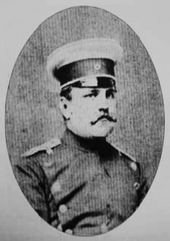Max von Spiessen
Max Otto Aloys Hubert Johann Maria von Spiessen (also: von Spießen ; born June 22, 1852 in Dülmen ; † November 5, 1921 in Münster ) was a Prussian officer, poet , genealogist and heraldist .
Life
Origin and family
Max von Spiessen was the son of District Court Judge Maria Levin Joseph Ludwig von Spiessen and his wife Maria Aloysia Engelberta, née von Rump . The paternal family traces its reliable line of tribe back to the 1699 documented Jobst Christoph von Spiessen, Herr auf Ebbinghausen , officer in Kurbrandenburg - then serving in the Electorate of Cologne . In 1881 Max von Spiessen married Theresia von Druffel , but the childless marriage was divorced in 1907. His brother August (1844–1915) was a royal chief forester and botanist.
Career
There are very different statements about Spiessen's career in the Prussian Army . It is certain that on April 12, 1873, he was promoted to Portepeef Ensign in the Westphalian Cuirassier Regiment No. 4 and on February 10, 1874, he was promoted to second lieutenant in the regiment . From March 12, 1878 to August 14, 1880 he was in command as an inspection officer and teacher at the war school in Metz . On November 16, 1880, Spiessen joined the regiment's reserve and was listed in the ranking as a reserve officer for another two years. From 1883 he was a cavalry officer in the 1st Battalion of the 1st Westphalian Landwehr Regiment No. 13 in Munster, then on February 12, 1884, he was approved to leave as Premier Lieutenant . During the First World War he was used in domestic military service.
Already during his active military service Spiessen spent a lot of time and effort with his genealogical and heraldic work in numerous archives, from 1878 to New Year's Eve 1919 he was a member of the renowned scientific association Herold zu Berlin . His diverse relationships with the Westphalian nobility enabled him to use many estate and family archives. In 1890 he moved from Dülmen to Münster. In March 1896 he was one of the founding members of the Historical Commission for Westphalia . He also made major trips to Sweden, England, Italy and Switzerland. His first and most highly regarded work was the coat of arms of the Westphalian nobility , published in three volumes from 1901 to 1903 , to which Adolf Matthias Hildebrandt contributed the coat of arms graphics. The publication of the family tables of the Westphalian nobility announced there in the foreword did not come about, probably not least due to the war.
estate
His collected copies, excerpts and notes were handed over to the Münster State Archives on the condition that his heirs should have access at all times. After the State Archives had taken over these documents in 1922, the collection was supplemented in 1929 by a donation from nephew Egon von Spiessen with an extensive collection of seals and seals from the estate of Spiessen. The literary estate went indirectly to the Dülmen city archive.
Works
- Book of arms of the Westphalian nobility. 3 volumes. Görlitz 1901–1903. Digitized
literature
- Ralf Oldenburg: The relationship of the poet Max von Spiessen to Dülmen. In: Dülmener Heimatblätter. Issue 1. 2005. (online)
- Biographical lexicon of heraldists, as well as sphragisticians, vexillologists and insignologists. (Johann Siebmacher's Large Wappenbuch Volume H), published by Herold, Association for Heraldry, Genealogy and Related Sciences in Berlin eV , edited by Jürgen Arndt with the help of Horst Hilgenberg and Marga Wehner, Neustadt an der Aisch 1992, p. 515.
Web links
- Biographical information on the website of the Historical Commission for Westphalia
- Max von Spießen on GenWiki
- Max von Spießen at Regesta Imperii
- Axel Koppetsch: Remnants of a genealogist's life. The Spiessen Collection in the Münster State Archives. (2008; PDF; 2.2 MB)
- Max von Spiessen in the Lexicon of Westphalian Authors
- Archives holdings
- genealogical estate of Max von Spießen in the Landesarchiv NRW Westphalia department
- prosaic estate of Max von Spießen in the Dülmen city archive: Max von Spiessen's estate in the Lexicon of Westphalian Authors
Individual evidence
- ^ Leopold von Zedlitz-Neukirch : New Prussian Adelslexicon . Volume 3, Leipzig 1837, p. 227.
- ↑ Ebbinghausen on Schlossarchiv.de
- ↑ The history of Ebbinghausen ( Memento of the original from October 21, 2014 in the Internet Archive ) Info: The archive link was inserted automatically and has not yet been checked. Please check the original and archive link according to the instructions and then remove this notice.
- ^ GHdA , Adelslexikon Volume XIII, Volume 128 of the complete series, Limburg an der Lahn 2002, p. 467.
- ↑ Alfred Blaufuss & Hans Reichert (1992): The flora of the Nahe region and Rheinhessen, 81.
- ↑ Wolfgang A. Mommsen : The bequests in the German archives. Boppard 1983, p. 1155.
| personal data | |
|---|---|
| SURNAME | Spiessen, Max von |
| ALTERNATIVE NAMES | Spießen, Max von; Spiessen, Max Otto Aloys Hubert Johann Maria von (full name) |
| BRIEF DESCRIPTION | Prussian officer, poet, genealogist and heraldist |
| DATE OF BIRTH | June 22, 1852 |
| PLACE OF BIRTH | Dülmen |
| DATE OF DEATH | November 5, 1921 |
| Place of death | Muenster |
